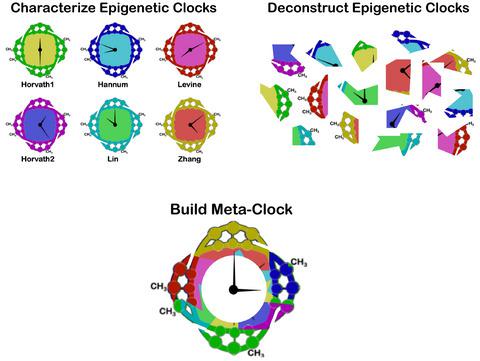当前位置:
X-MOL 学术
›
Aging Cell
›
论文详情
Our official English website, www.x-mol.net, welcomes your feedback! (Note: you will need to create a separate account there.)
Underlying features of epigenetic aging clocks in vivo and in vitro.
Aging Cell ( IF 7.8 ) Pub Date : 2020-09-15 , DOI: 10.1111/acel.13229 Zuyun Liu 1, 2 , Diana Leung 1 , Kyra Thrush 1 , Wei Zhao 3 , Scott Ratliff 3 , Toshiko Tanaka 4 , Lauren L Schmitz 5 , Jennifer A Smith 3 , Luigi Ferrucci 4 , Morgan E Levine 1
Aging Cell ( IF 7.8 ) Pub Date : 2020-09-15 , DOI: 10.1111/acel.13229 Zuyun Liu 1, 2 , Diana Leung 1 , Kyra Thrush 1 , Wei Zhao 3 , Scott Ratliff 3 , Toshiko Tanaka 4 , Lauren L Schmitz 5 , Jennifer A Smith 3 , Luigi Ferrucci 4 , Morgan E Levine 1
Affiliation

|
Epigenetic clocks, developed using DNA methylation data, have been widely used to quantify biological aging in multiple tissues/cells. However, many existing epigenetic clocks are weakly correlated with each other, suggesting they may capture different biological processes. We utilize multi‐omics data from diverse human tissue/cells to identify shared features across eleven existing epigenetic clocks. Despite the striking lack of overlap in CpGs, multi‐omics analysis suggested five clocks (Horvath1, Horvath2, Levine, Hannum, and Lin) share transcriptional associations conserved across purified CD14+ monocytes and dorsolateral prefrontal cortex. The pathways enriched in the shared transcriptional association suggested links between epigenetic aging and metabolism, immunity, and autophagy. Results from in vitro experiments showed that two clocks (Levine and Lin) were accelerated in accordance with two hallmarks of aging—cellular senescence and mitochondrial dysfunction. Finally, using multi‐tissue data to deconstruct the epigenetic clock signals, we developed a meta‐clock that demonstrated improved prediction for mortality and robustly related to hallmarks of aging in vitro than single clocks.
更新日期:2020-10-23


























 京公网安备 11010802027423号
京公网安备 11010802027423号